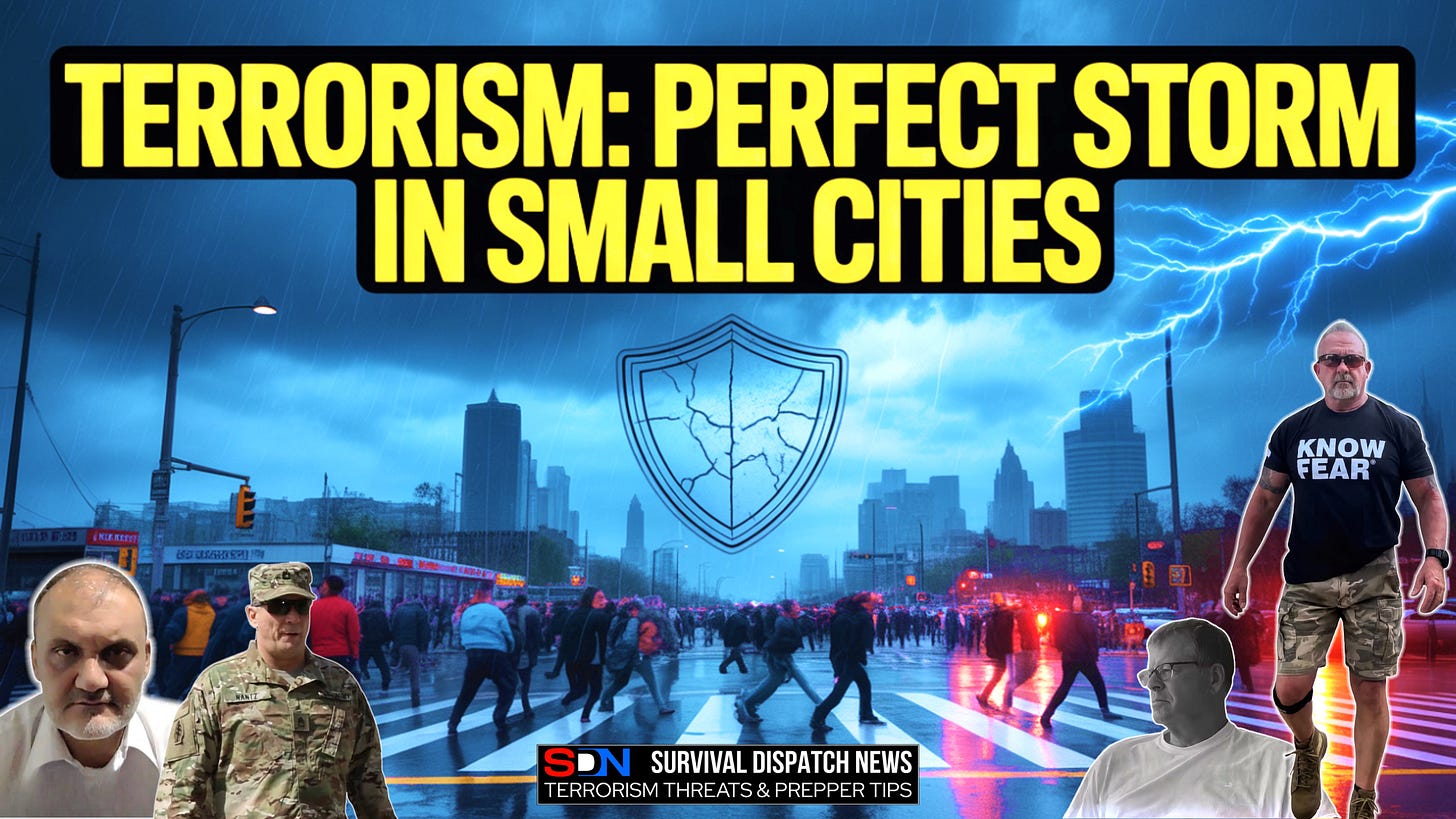SITREP: Small Cities, Big Problems: America's Vulnerability EP555
Watch the recorded episode here
The SDN SITREP 8-7-25
📡 INTEL BRIEFING
What if the next 9/11 doesn't come from the skies, but from inside your own city?
Watch the recorded episode on Substack HERE.
BLUF MAIN TOPIC: Tier-Two Cities - America's Soft Underbelly. These cities are the perfect storm: minimal law enforcement, limited medical facilities, high foot traffic and low preparedness.
America's secondary cities have become our nation's most vulnerable soft targets. These tier-two urban centers present a dangerous convergence of critical weaknesses that make them ideal targets for those who wish to inflict maximum damage on our communities. With police departments operating at 30-year staffing lows and rural hospitals closing at alarming rates, these communities lack the essential infrastructure needed to respond to crisis situations.
Grab our FREE terrorism preparedness guide …
Keep reading below the thumbnail ...
The reality is stark - many of these cities are operating with skeleton law enforcement crews that would struggle to handle even a moderate emergency, let alone a coordinated attack. Small police departments nationwide report they can barely maintain basic patrol coverage, with some losing entire shifts when officers quit without notice. Meanwhile, nearly 200 rural hospitals have shuttered since 2005, leaving massive medical deserts where emergency care is hours away.
What makes this crisis even more dangerous is that these vulnerable cities often sit along major transportation corridors, drawing substantial foot traffic and commerce. They become perfect storm locations where high visibility meets low protection. Criminal elements and potential terrorists understand that striking these communities would create maximum psychological impact while facing minimal resistance. These cities represent the soft underbelly of American security infrastructure, and we ignore this vulnerability at our own peril.
DISCLOSURE: This post contains affiliate links. If you make a purchase through them, we may earn a small commission at no extra cost to you. This helps keep our work independent. Thank you for your support.
PRACTICAL TIPS | MAIN TOPIC
Understanding your local security environment is the first step in protecting yourself and your family from the growing vulnerabilities in America's tier-two cities. Start by conducting a realistic assessment of your community's emergency response capabilities. Research your local police department's actual staffing levels, not their authorized strength. Find out average response times to your neighborhood and identify the nearest fully-equipped medical facility that can handle serious trauma.
Create multiple evacuation routes from your home and workplace, because if your local hospital is understaffed or closed, you'll need to reach the next nearest facility quickly. Keep updated maps in your vehicle showing alternative routes to major medical centers, and ensure your family knows these routes by heart. Consider the reality that during a crisis, your small-town emergency services may be overwhelmed or temporarily unavailable.
Develop neighborhood watch networks that can serve as force multipliers for limited police resources. Train with like-minded community members in basic first aid and trauma care, since medical help may be delayed. Stock medical supplies beyond basic band-aids - include items for controlling severe bleeding, treating shock, and stabilizing injuries during transport. Most importantly, maintain situational awareness and trust your instincts. In communities with stretched resources, your personal vigilance becomes even more critical.
LIMITED TIME OFFER Get 20% off your GUARDIAN membership FOREVER ...
https://survivaldispatchnews.substack.com/20off
EXCLUSIVE CONTENT | MAIN TOPIC
The harsh reality facing everyday Americans in these vulnerable communities requires immediate action and long-term strategic thinking. Citizens can no longer rely solely on understaffed government services to provide adequate protection and emergency response. This means taking personal responsibility for family security and community resilience in ways our grandparents would recognize but many modern Americans have forgotten.
Start by forming mutual aid networks with trusted neighbors who share your values and commitment to community defense. These relationships become invaluable when official response systems are overwhelmed or unavailable. Coordinate communication plans using alternative methods like amateur radio, since cell towers may be compromised during emergencies. Establish neighborhood security patrols and create informal but effective early warning systems for suspicious activity.
Invest in medical training that goes beyond basic first aid - consider wilderness first responder courses or tactical medical training that prepares you for scenarios where professional medical help is delayed or unavailable. Stock appropriate supplies and equipment that can bridge the gap until advanced care becomes available. This isn't paranoia; it's practical preparation for the documented reality of limited emergency services in many American communities.
Most critically, engage in local politics and community leadership. Attend city council meetings, support law enforcement funding initiatives, and advocate for policies that strengthen rather than weaken your community's defensive capabilities. The erosion of local security infrastructure didn't happen overnight, and rebuilding it will require sustained citizen engagement. Remember that in God's providence, He often works through prepared and engaged citizens to protect their communities.
COMMUNITY SPOTLIGHT
Thank you JJ Morris for the best story today "Why the SIG P320 cannot be trusted":
https://www.survivaldispatch.news/p/why-i-cant-trust-the-sig-p320-anymore
JOIN THE CRUSADE!
Help us save our republic & Christian culture by sharing our publication.
Email questions to Support@SurvivalDispatch.com
Godspeed,
Chris Heaven, CEO
Survival Dispatch
Sources for this SITREP follow below ...








